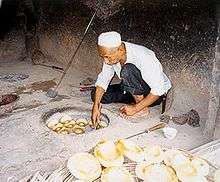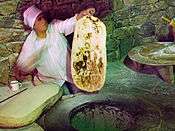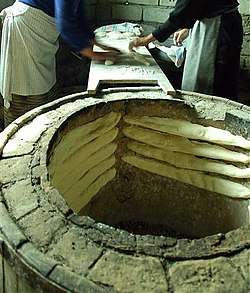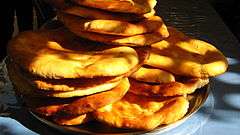Tandoor bread
 Tandoor baking in Kashgar in China | |
| Place of origin | Iraq (Ancient Mesopotamia) |
|---|---|
| Main ingredients | Flour |
Tandoor bread (Arabic: خبز تنور khubz tannoor)[note 1] is a type of leavened[1] bread baked in a clay oven called a tandoor,[2][3] similar to naan.
In the Indian subcontinent, tandoor breads are popular especially in the Khyber Pakhtunkhwa, Gujarat, Jammu and Kashmir, Rajasthan and Punjab regions, where naan breads are baked in tandoor clay ovens fired by wood or charcoal. These tandoor-prepared naans are known as tandoori naan.[4]
Tandoori roti is also known as taftoon, and it is commonly consumed in South Asian countries such as Iran, Pakistan, and India as the main wheat-based product[5]. This bread is served in restaurants, hotels, industrial canteens, and home. It is also gaining popularity in the continents of Asia and Europe[6].
History
Cooking food in tandoori oven has been around for about five millennia. Remains of the clay oven has been excavated in the Indus River valley, present-day Afghanistan, Pakistan, northwest India, Iran, and Central Asia.[7]
Tandoori ovens are not prevalent in the average Indian home because they are expensive to fabricate, install, and maintain.[8] Authentic tandoori cuisine in urban areas can often be found in specialty restaurants.[7] However, in rural areas in India such as Punjab, the tandoori oven is considered a social institution, for a tandoori oven is shared among the community. Women would go to the oven place with atta along with their marinated meats to meet their neighbors and friends, so they could converse and share stories while waiting for their food to cook.[9] The people in cities once engaged in this social activity, but as businesses and commercialism grew in these areas, communal tandoori ovens have become rare. Not uncommonly, people bring food to their local bakeries to cook it there at a fair price.[7]
Because of the growing inaccessibility of a tandoori oven in urban areas, especially in cities outside of Southern Asia, people have developed ingenious techniques to replicate the cooking process and the food without the use of the oven. Common alternatives include an oven or a grill fueled by charcoal or wood so the food will be infused with the smoky flavor.[7]
Preparation
Tandoori bread is made by kneading flour, active dry yeast, salt, and water together until the dough becomes uniformly firm into a disc of 2- to 3-mm thickness, 15- to 20-cm diameter and a weight of 50-60 g. Then, it is divided by serving sizes, proofed or set aside for fermentation, docked or poked holes through to let the dough rise.[7] Once it is shaped, the dough is placed on the walls of the tandoori oven. The dough is placed onto the heated inner walls of the tandoor and allowed to bake for 37 seconds at [around] 425°C.[6]
The bread is baked until it reaches uniform thickness, develops small blisters on the top crust, and achieves a reddish-brown crust color. Tandoor bread is commonly served with meats that were also cooked in the oven like tandoori chicken, seekh kebob, or chicken Moghlai.[5] Meals made in the tandoori oven come out with a hint of infused smoky flavor, which makes it a special delicacy in Southern Asia.[6][7]
Physical and chemical composition
Production of tandoor bread is based on seven different phases: survey of current practice, design and installation of a tandoor, and development of standardized procedure for tandoori bread production, development of an evaluation scheme for tandoori breads, development of a reference set of grain and flour samples, investigation of the significance of parameters, and investigation of the relationship between wheat and flour parameters and tandoori bread quality.[10]
Aroma, smell, appearance, color, and size, and overall texture are the general characteristics that are optimized by producers of tandoor bread.[6] The texture and quality of tandoor bread are determined by the percentage of wheat protein, the number of essential amino acids, and type of flour present in the bread.[11] Various studies have demonstrated that the chemical and biochemical composition of flours affects the flour’s ability to interact with the other ingredients in tandoor bread.[6][11]
Response surface methodology is a process which allows for development of palatable tandoor breads that have a long shelf life and contain minimal amounts of polycyclic aromatic hydrocarbons.[12] For optimal sensory and chemical stability of tandoori bread, the water level is 720 milliliters per kilogram, protein concentrations range from 10.3% to 11.5%, between 1.2 and 1.6% salt is added, and the bread is baked in temperatures ranging from 330 to 450°C.[5]
Health hazards
Sixteen different polycyclic aromatic hydrocarbons are present in tandoor bread. .[13]
Gallery

 Baking tandoor bread in Azerbaijan
Baking tandoor bread in Azerbaijan
 Prepared tandoor bread
Prepared tandoor bread Making tandoor bread in India
Making tandoor bread in India
Notes
- ↑ Armenian: թոնիր հաց tonir hats, Azerbaijani: Təndir çörəyi, Georgian: თონის პური tonis puri, Gujarati: તંદૂરી નાન tandūrī nāna, Hindi: तंदूर नान tandoori naan, Kazakh: тандыр нан tandyr nan, Kyrgyz: тандыр нан tandyr nan, Persian: نان تنوری nan-e-tanuri, Tajik: нони танурй noni tanuri, Turkish: Tandır ekmeği, Uyghur: تونۇر نان tonur nan, тонур нан, Uzbek: tandir non
Citations
- ↑ http://bksoc-shop.org.uk/blogs/news/18863979-recipe-tandyr-nan
- ↑ http://kabobcentral.com/tandoorbpage.html
- ↑ "Archived copy". Archived from the original on 2008-12-21. Retrieved 2011-01-06.
- ↑ Cavendish, Marshall (2007). Peoples of Western Asia. Marshall Cavendish Corporation. p. 336. ISBN 978-0761476771.
- 1 2 3 Gocmen, D.; Inkaya, A.N.; Aydin, E. (2009). "Flat Breads" (PDF). Bulgarian Journal of Agricultural Science. 15: 298–306.
- 1 2 3 4 5 "Indian wheat cultivars: their carbohydrate profile and its relation to tandoori roti quality". Food Chemistry. 68: 185–190. 2000 – via Science Direct.
- 1 2 3 4 5 6 Chandra, Smita (1999). Indian Grill: The Art of Tandoori Cooking. Manhattan: The Ecco Press. ISBN 0880016876.
- ↑ Jaffrey, Madhur (2011). An Invitation to Indian Cooking. New York City: Knopf. ISBN 0375712119.
- ↑ Malhi, Manju (2005). India with Passion: Modern Regional Home Food. Northampton: Interlink Pub Group Inc. ISBN 1566566096.
- ↑ Hasmi, Irfan A. (1996). "Wheat and flour properties affecting tandoori bread quality". vuir.vu.edu.au. Werribee, Australia: Victoria University of Technology. Retrieved 2018-03-06.
- 1 2 Galali, Yaseen (2014). "Quality and Shelf-life of Pita and Tandoor Breads Supplemented with Three Novel Functional Ingredients". Plymouth University – via Pearl.
- ↑ Kumar, Brijesh (August 2017). "Profiling and Health Risk Assessment of PAHs Content in Tandoori and Tawa Bread from India". Polycyclic Aromatic Compounds.
- ↑ Chawda, Shruti; Tarafdar, Abhrajyoti; Sinha, Alok; Mishra, Brijesh Kumar (2017). "Profiling and Health Risk Assessment of PAHs Content in Tandoori and Tawa Bread from India". Polycyclic Aromatic Compounds. doi:10.1080/10406638.2017.1349679.
